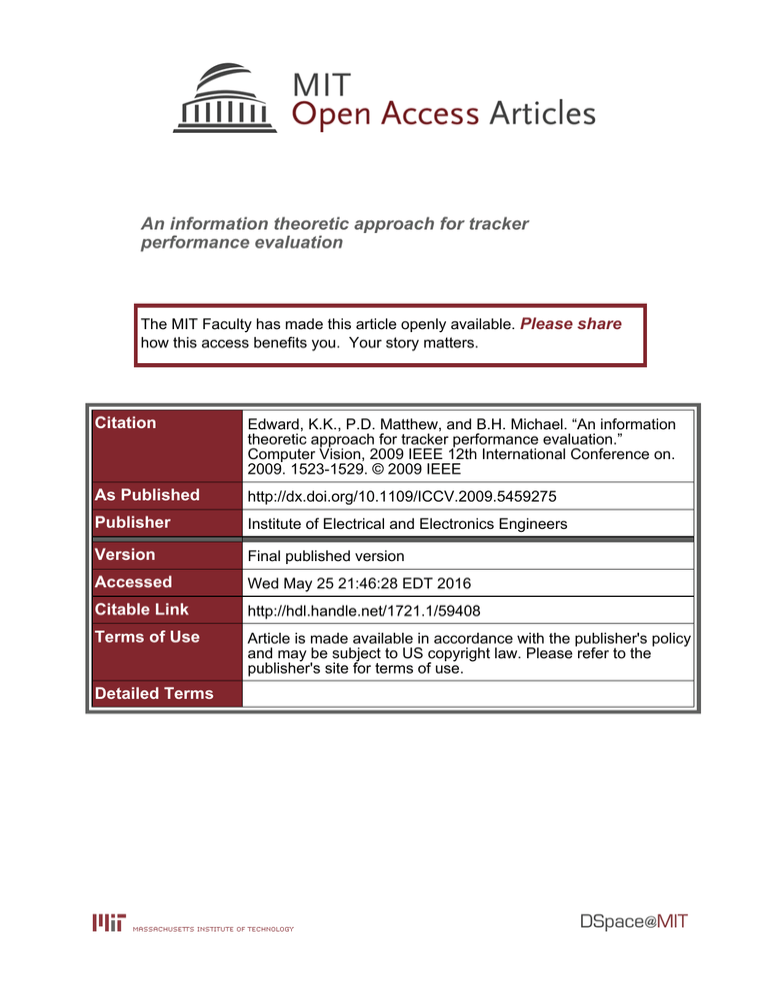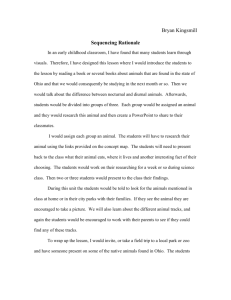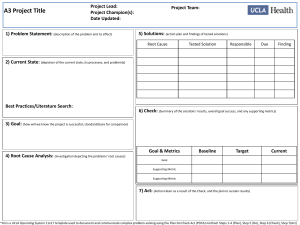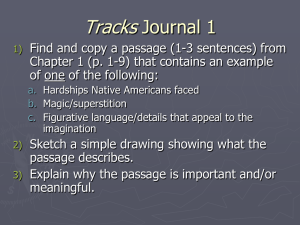An information theoretic approach for tracker performance evaluation Please share
advertisement

An information theoretic approach for tracker
performance evaluation
The MIT Faculty has made this article openly available. Please share
how this access benefits you. Your story matters.
Citation
Edward, K.K., P.D. Matthew, and B.H. Michael. “An information
theoretic approach for tracker performance evaluation.”
Computer Vision, 2009 IEEE 12th International Conference on.
2009. 1523-1529. © 2009 IEEE
As Published
http://dx.doi.org/10.1109/ICCV.2009.5459275
Publisher
Institute of Electrical and Electronics Engineers
Version
Final published version
Accessed
Wed May 25 21:46:28 EDT 2016
Citable Link
http://hdl.handle.net/1721.1/59408
Terms of Use
Article is made available in accordance with the publisher's policy
and may be subject to US copyright law. Please refer to the
publisher's site for terms of use.
Detailed Terms
An Information Theoretic Approach for Tracker Performance Evaluation
Edward K. Kao, Matthew P. Daggett, Michael B. Hurley
Intelligence and Decision Technologies Group
MIT Lincoln Laboratory
244 Wood Street, Lexington, MA 02420-9185
{edward.kao, daggett, hurley}@ll.mit.edu
Abstract
1. Introduction
Automated tracking of vehicles and people is essential
for the effective utilization of imagery in wide area
surveillance applications. In order to determine the best
tracking algorithm and parameters for a given
application, a comprehensive evaluation procedure is
required. However, despite half a century of research in
multi-target tracking, there is no consensus on how to
score the overall performance of these trackers. Existing
evaluation approaches assess tracker performance
through measures of correspondence between ground
truth tracks and system tracks using metrics such as track
detection rate, track completeness, track fragmentation
rate, and track ID change rate. However, each of these
only provides a partial measure of performance and no
good method exists to combine them into a holistic metric.
Towards this end, this paper presents a pair of information
theoretic metrics with similar behavior to the Receiver
Operating Characteristic (ROC) curves of signal detection
theory. Overall performance is evaluated with the
percentage of truth information that a tracker captured
and the total amount of false information that it reported.
Information content is quantified through conditional
entropy and mutual information computations using
numerical estimates of the probability of association
between the truth and the system tracks. This paper
demonstrates how these information quality metrics
provide a comprehensive evaluation of overall tracker
performance and how they can be used to perform tracker
comparisons and parameter tuning on wide-area
surveillance imagery and other applications.1
As video surveillance systems continue to cover larger
areas at higher resolutions, the need for automated tracking
systems becomes increasingly strong so that the full use of
all collected imagery can be accomplished by narrowing
human analysis to those frames where automated trackers
have detected interesting features. An overall scoring function is needed to evaluate different trackers so that users
can select the one that is most effective for their
application. Such a scoring function must be mathematiccally sound and comprehensive in capturing the significant
characteristics of tracker performance.
The same users usually have no difficulty articulating
what they want in a tracking system and can often provide
narratives of what they expect it to do. These descriptions
suggest that a utility scoring function is what is desired, but
the users often do not have sufficient knowledge of the
costs and benefits of the tracking system for an analysis of
utility to be conducted. The tracker behaviors that are
articulated often relate to different track pathologies, such
as missed tracks, false tracks, track fragmentations, track
merges, and tracks that are too long or too short.
In order to capture the various track behaviors and
pathologies, tracker performance metrics like detection
rate, completeness, fragmentation rate, and ID change rate,
etc. [1][2][3][4][5] have been proposed. However, each
metric only addresses a subset of the track pathologies and
a single pathology often affects multiple metrics. To obtain
an overall score of tracker performance, these metrics are
often combined through an ad-hoc weighted sum. The
weights are used to adjust the score to account for users’
unique needs. However, choosing a set of weights that is
fair for algorithm comparison and reflects the requirements
of a given application is difficult, especially when the
metrics are in different units and are often highly
correlated.
An overall scoring function based upon a theoretical
foundation eliminates the problems of selecting weights
and resolving conflicting results when some metrics
improve and others degrade. This paper presents an
information theoretic metric that provides an overall
1
This work was sponsored by the Department of Defense under Air
Force Contract FA8721-05-C-0002. Opinions, interpretations,
conclusions, and recommendations are those of the authors and are not
necessarily endorsed by the Department of Defense or the United States
Air Force.
1523
2009 IEEE 12th International Conference on Computer Vision (ICCV)
978-1-4244-4419-9/09/$25.00 ©2009 IEEE
truth track i , and " j the length of system track j . Figure
1 demonstrates the computation of completeness using a
one-to-one association and a many-to-many association
through an example where multiple track pathologies are
present. In this example,
scoring function and captures the effects of common track
pathologies. The approach is related to prior work in
medical test performance evaluation [6], medical decision
making [7] and inspection performance [8] but extends
that work from a binary detection problem to a
multi-assignment problem. Furthermore, an additional
false information quantity is added to construct ROC-like
performance plots and an overall scoring function is
proposed over this two-dimensional metric space.
There has been an on-going effort in the design of
tracker evaluation procedures in the last few years with
much work presented in the Workshop on Performance
Evaluation of Tracking and Surveillance (PETS). In
general, the evaluation procedure involves running a
tracking algorithm on a test set and comparing the resulting
system tracks to the ground truth tracks [9]. The
correspondence between the system tracks and truth tracks
is established through an association algorithm. Different
metrics have been proposed to capture the quality of the
correspondence. Earlier works by Senior [1] and Ellis [2]
assess correspondence between truth tracks and system
tracks through metrics similar to those of a detection ROC
curve. Their proposed metrics focus on the fraction of truth
tracks observed by the system (analogous to the
probability of detection), as well as the fraction of system
tracks that correspond to the truth tracks (one minus this
quantity is analogous to the false alarm rate). For the
purpose of discussion, these metrics will now be referred
to as truth completeness ( CT ) and track completeness ( C S ).
Later works by Brown [3] and Bashir [4] continue to use
the completeness metrics; however, they emphasized its
limit in evaluating performance in the presence of track
fragmentation and track merging. Towards this end, they
proposed a new way to compute completeness using a
many-to-many association between the system tracks and
the truth tracks. Equation (1) and (2) define the completeness metrics in the many-to-many association case (i.e. CTM
and CSM ) and the one-to-one association case (i.e. CTO and
CSO ) respectively, where T is the set of all truth tracks, S
ij
iT jS
CTM
CSM
i
C
¦ max("
¦"
iT
jS
i
iT
ij
O
S
C
C SO
(7 6) (11 6 8)
"1A
7
Gap
6
1
4
2
"2A
B
2
2
Fragmentation + Gap
1
Truth
Tracks
A
System
Tracks
8
C
False Track
Figure 1. Two truth tracks and three system tracks with
multiple track pathologies.
However, neither of the two completeness computation
methods gives a comprehensive overall correspondence
between the truth tracks and the system tracks. Figure 2
demonstrates six scenarios when tracking two vehicles that
pass each other at a traffic intersection. Five cases are
presented with common track pathologies. A desirable
Perfect (
)
Fragment (
2
)
Gap (
2
)
2
A
A
A
B
1
1
B
C
1
B
1
1
D
2
(1)
Extra (
2
ij
1
1
1
B
A
1
j
)
2
A
A
B
Fragment (
and Gap
)
2
)
(2)
2
Merge (
)
2
iT
52% .
A Merge
" 2B
ij
¦ max("
¦"
68% ,
3
1
1
jS iT
jS
C
(7 6) (10 12) 59% ,
Time Samples
jS
)
(7 4 6) (11 6 8)
O
T
The differences between the two completeness computation methods are made evident here by the track fragmentation and merge.
j
iT
O
T
¦¦ "
¦"
M
S
C
2. Existing Tracking Metrics
¦¦ "
¦"
(7 6 4) (10 12) 77% ,
CTM
1
B
C
1
D
jS
2
the set of all system tracks, " ij the length of association
between truth track i and system track j , " i the length of
2
2
Figure 2. Six scenarios at a traffic intersection with
common track pathologies.
1524
3. Information Theoretic Metrics
metric would show performance degradation reflecting the
presence and severity of each pathology. As shown in
Figure 3, both existing completeness metrics are limited in
their capacity towards this end. In order to show the
analogy to a detection ROC curve, the x-axis represents
track “incompleteness” which is simply one minus track
completeness. Note that both types of completeness
Many-to-Many
Completeness
Information theoretic metrics can be used to evaluate
tracker performance by interpreting tracker data as
messages received over a communications channel where
the truth data are the original messages. If the truth dataset
is known, the information theoretic metrics can be easily
calculated. For this paper, it is assumed that the truth
dataset is a complete description of the objects of interest.
The typical joint entropy diagram [11] in Figure 4 displays
a graphical representation of the five information measures
that are relevant to tracker performance evaluation: truth
track entropy H T representing the total amount of the
truth tracks’ information, system track entropy H S representing the total amount of the system tracks’ information,
mutual information I T ; S representing the amount of
matching information between the truth tracks and system
tracks, truth conditional entropy H T | S representing the
amount of truth tracks information missed by the system
tracks, and tracker conditional entropy H S | T representing the amount of false information introduced by the
system tracks.
One-to-One
Completeness
1
Truth
Completeness
Truth
Completeness
1
0.5
0
Track
Incompleteness
0.5
0.5
0
Track
0.5
Incompleteness
Figure 3. A comparison on the two completeness
computation methods in six different scenarios of two
crossing tracks at a traffic intersection.
Truth Track
Information
System Track
Information
metrics fail to distinguish each of the five pathological
scenarios. Completeness computed with one-to-one
association only considers the single track with the longest
association. It disregards all other tracks and fails to
distinguish a single pathology from a combination of them,
as demonstrated here with the single fragment case ( )
versus the fragment and gap case ( ). It also tends to overly penalize track fragmentation ( ) and track merging
( ). Correspondingly, completeness computed from
many-to-many association does not penalize track fragmentation ( ) and track merge (
). As a result, these
completeness metrics are inadequate in evaluating a
complete multi-target tracking system where track
fragmentation and track merging are typical pathologies.
Works by Bashir [4] and Yin [5] included the number of
track fragmentations and merges as separate metrics.
While all these proposed metrics together respond to all
track pathologies, each of them only provides a partial
performance measure and no good method exists to
combine them into a holistic metric. In the next section, a
single metric based on information theory will be
described which captures all the aforementioned track
pathologies and provides a comprehensive overall
performance measure. This work is not to be confused with
Loutas’ appearance-based information theoretic tracker
evaluation approach in [10] where comparison is made
between the object reference chip and the track chip. This
paper takes a different approach by measuring directly the
similarity between the truth and the observed track states.
H T H S H S | T I S ; T Mutual
Information
False
Information
H T | S Missed
Information
Figure 4. Relationship between truth tracks and
system tracks in information space.
A single score based upon information alone can be
calculated by summing the two conditional entropies. This
score measures the amount of true information that a
tracker missed plus the amount of false information that it
generated. An optimal tracker from an information
theoretic perspective minimizes this score:
SI
H T | S H S | T .
(3)
Considering the quantities in H (T ) I T ; S H (T | S ) and
I T ; S H ( S | T ) , the five unique terms are interrelated and can be collapsed into three terms. Truth entropy,
mutual information, and tracker conditional entropy have
been selected as the three terms to use for more in-depth
evaluation.
Because comparisons between trackers or algorithm
parameters are best made with the same truth dataset, the
entropy of the truth dataset can be used to normalize the
mutual information and tracker conditional entropy and
H (S )
1525
reduce the number of variables directly used in the
evaluation to two:
I T ; S / H T ,
(4)
r S | T H S | T / H T .
(5)
f (T ; S )
generate the joint probability density function. The first
row (column) of the matrix is used to record the counts of
the number of times that truth (system) tracks did not
associate with any system (truth) tracks. Each additional
row (column) in the matrix is for a specific truth (system)
track.
The score SI can be normalized as well when comparing
different trackers and parameters against a common truth
set. The truth information completeness f (T ; S ) is a
measure of the fraction of truth information collected by a
tracker, which has been previously called the ‘fraction of
uncertainty removed’ by Raz [8]. The false information
ratio r S | T is the ratio of false information to truth
information. Figure 5 shows the information coverage plot
composed of these two quantities. The plot has many
similarities to the ROC curve: perfect tracker performance
is at the point (0, 1) (zero false information generated and
all truth information captured). Also shown is the notional
impact of the aforementioned track pathologies on the
performance in this metric space. Curves can be traced
through the two-dimensional space by the variation of a
single tracker parameter; overall better trackers will
generate curves closer to the upper-left corner in the graph
than overall poorer trackers.
Truth Tracks
System Tracks
Fragment, False Tracks
Truth Information
Completeness
Tracks
Too Short
Missing
Tracks
Merges
0
0
H (S | T )
H T False Information
Ratio
S2
SM
Ø
# Unused
States
# ~Assoc.
for S1
# ~Assoc.
for S2
# ~Assoc.
for SM
T1
# ~Assoc.
for T1
# Assoc.
(T1, S1 )
# Assoc.
(T1, S2 )
# Assoc.
(T1, SM )
T2
# ~Assoc.
for T2
# Assoc.
(T2, S1 )
# Assoc.
(T2, S2 )
# Assoc.
(T2, SM )
TN
# ~Assoc.
for TN
# Assoc.
(TN, S1 )
# Assoc.
(TN, S2 )
# Assoc.
(TN, SM )
An association algorithm is used to determine the
assignment of system tracks to truth tracks. Both sets of
tracks are defined on a common state space and
represented as Gaussian probability density functions.
Association costs between truth and system tracks are
generated by integrating pairs of Gaussian functions. A
threshold association cost must be selected to set the
threshold between assignments and non-assignments. This
is an evaluation parameter that should be analyzed to
determine the sensitivity of the information scores to
different thresholds. The results of this paper were
generated through the use of normalized Mahalanobis
distances and a linear assignment algorithm. Additional
details on track association can be found in [12] and [13].
An important subtlety with the conversion of association
counts to probabilities is that an estimate of the true
negatives is needed, i.e. the number of times that a tracker
did not report a track when there was no real track present.
This value populates the (Ø, Ø) entry in the accumulation
matrix. The approach adopted here is to estimate the total
number of states that can reasonably exist in the tracker
state space and then subtract the total number of counts in
all the other entries in the matrix. For video data, the
number of frames, times the total size of the state space,
divided by the resolution limit in the state space is a
reasonable estimate for the total number of states. The
maximum number of position states per frame is no more
than the number of pixels. The velocity limits and
resolutions can usually be determined from the dynamics
of the objects of interest and tracker performance
requirements.
Tracks
Too Long
I S ; T H T S1
Figure 6. Track association table used to generate
the joint probability.
Information Coverage Plot
1
Ø
N
Figure 5. Different track pathologies drive the
performance metrics in different directions in the
proposed information theoretic metric space.
The principal function needed to calculate the
information metrics is a joint probability density function
between the truth and system tracks. A simple technique
for generating a joint probability density function is to
select a series of times to compare tracker data with truth
data. The best association between the system tracks and
the truth tracks is determined for each time sample. The
numbers of times that tracks in the two sets associate and
do not associate are counted. As shown in Figure 6, the
counts are stored in a two-dimensional matrix and used to
1526
The accumulation matrix is then normalized by the total
state estimate to generate a joint probability density
function Ps, t . The system and truth track probability
functions Ps and Pt , can be calculated by the normalizeed sums along rows or columns in the association table.
The conditional probability density functions Pt | s and
Ps | t are simply Ps, t / P( s) and Ps, t / P(t ) . The
information metrics can be easily computed from these
probability terms using the following equations [11]:
H T ¦ Pt logP t ,
(6)
H S ¦ P s logP s ,
(7)
H S | T ¦ Ps, t logPs | t ,
(8)
H T | S ¦ Ps, t logPt | s ,
(9)
combinations of track pathologies. This can be observed
by the similarity in the deterioration of performance from
the perfect case (
) to the gap case (
) and from the
fragment case ( ) to the fragment-plus-gap case ( ).
4. Applications
Wide area surveillance for activity recognition and
event reconstruction requires information on the
movement of vehicles and people. The large area of regard
and hours upon hours of video imagery make the
exploitation of such data very daunting for human
analysts. Automated tracking can significantly reduce
analyst workloads, enabling analysts to quickly find all the
objects that had entered a certain area at a certain time, as
well as all the places an object of interest has visited.
Moreover, post-processing of tracks in an automated event
detection algorithm can cue analysts to more thoroughly
inspect specific data for anomalous behavior.
However, automated tracking in video imagery remains
a difficult problem, especially in an urban area where
traffic volume can be large and occlusion is prevalent in
the scene. Figure 8 shows an example of such operating
environment. The wide area coverage was accomplished
by stitching images collected by an array of six cameras
from an airborne platform flying over Ohio State
University. As shown by the example system tracks, track
fragmentation and track merge are common pathologies at
a traffic intersection as crowds of vehicles come to stop
next to each other and become difficult for the tracker to
distinguish. Also shown are false tracks caused by
spurious detections from imperfect image registration, as
well as gaps in the system tracks caused by occlusions.
t
s
s ,t
s ,t
§ P s, t ·
I T ; S ¦ Ps, t log¨¨ Ps Pt ¸¸ .
©
s ,t
¹
(10)
Figure 7 shows the common track pathology cases
presented earlier (see Figure 2). Unlike the existing
completeness metrics, the information theoretic metrics are
not only able to distinguish each case but provide results
that are proportional to the intuitive severity of the track
pathologies. The ordering of each case here is according to
Information Coverage Plot
1st
Truth Information
Completeness
1
5th
3rd
2nd
3rd
6th
0.5
0
False Information 0.5
Ratio
Figure 7. The information coverage plot effectively
evaluates common track pathologies.
the overall score function described in Equation (3). It is
worth noting the metric’s preference of fragments ( )
over merges ( ). Such a preference is intuitive because
truth tracks can be perfectly reconstructed from connecting
segments of system tracks while truth tracks cannot be
reconstructed after a merge. Additional information on the
precise location of the merge is needed to reconstruct the
truth tracks. In other words, merges result in an
informational loss on the truth track’s coverage. Another
nice feature is the information metrics’ ability to handle
Figure 8. Wide area surveillance in urban environment
with some example system tracks. Image from the
AFRL CLIF dataset [14].
In order to optimize tracking performance under such
challenging environment, the proposed information
theoretic metric is used to determine the tracking algorithm
1527
and parameter value that produces system tracks that
capture the most information on the truth tracks while
minimizing the amount of false information introduced.
Figure 9 shows the performance of two different
tracking algorithms as the detection threshold parameter is
varied. The dotted lines represent the points in the metric
space with equal amount of erroneous information (recall
Equation (3)). Lines towards the upper left hand corner
represent better overall performance. In applications where
the amount of missed information is not equally important
to the amount of false information, one may add weights to
the terms in Equation (3). This simply causes the slope of
the dotted lines to change. In this example, tracking
algorithm 1 dominates algorithm 2 in the detection
threshold parameter space. However, in cases where the
performance curves cross, the choice of the winning
algorithm will depend on the operating region (i.e. the
relative importance between missed and false
information).
1
Truth Information Completeness
Area for joint parameter tuning
Truth Information Completeness
Tracking Algorithm 2
0.2
0.4
Constant Erroneous
Information
0.6
0.8
1
Varying Tracker
Process Noise
0.2
Constant Erroneous
Information
Higher Detection
Threshold
0
0.2
0.4
0.6
0.8
1
1.2
An information theoretic metric has been derived to
evaluate the overall performance of multi-target trackers.
Results on a set of common track pathologies demonstrate
the new metric’s effectiveness over the existing
completeness metrics by capturing the impact of common
track pathologies on overall performance. The proposed
metric has been applied to a set of wide-area-surveillance
video imagery for tracker algorithm comparison and
parameter tuning. The ROC-like information coverage
plot provides an effective means by which to compare and
visualize the overall performance between different
trackers. It also allows performance curves to be generated
as tracker parameters are adjusted for optimal
performance.
The information theoretic metrics can be used to
evaluate the effects from changes to any part of the
wide-area video surveillance processing chain, from
sensors, to data registration and reduction, movement
detection, and target tracking. The metrics are general so
that they can be easily applied for performance evaluation
in other application areas where the system observation
and the ground truth can be expressed in an N-to-M
mapping, such as for classification and recognition
algorithms.
Additional work remains in order to fully evaluate the
utility of this information theoretic evaluation technique.
First, the sensitivity of the information theoretic metrics to
parameters within its own algorithm remains to be fully
analyzed. Although not presented, preliminary evaluation
on the sensitivity of the information theoretic metrics to the
estimation of the size of the overall state space and the
association threshold parameter has shown that, while the
magnitudes of the resulting metrics value change, the
relative positions on the information coverage plot for
Tracking Algorithm 1
0
Varying Detection
Threshold
5. Conclusion
0.4
0
Lower
Process Noise
0.4
Figure 10. Parameter tuning using the
information coverage plot.
Lower Detection
Threshold
Higher Detection
Threshold
Higher
Process Noise
0.6
False Information Ratio
0.8
0.2
0.8
0
1
0.6
Lower Detection
Threshold
1.2
False Information Ratio
Figure 9. Algorithm comparison using the
information coverage plot.
Figure 10 shows the performance curves of tracking
algorithm 1 when two different parameters are varied.
Varying the detection threshold adjusts the detection
sensitivity so it is not surprising to see the corresponding
curve take a shape of a typical detection ROC curve. On
the other hand, the tracker process noise curve displays a
very different shape. The optimal parameter value can be
simply determined as the point closest to the most
upper-left dashed line. In theory, the tracker process noise
parameter is orthogonal to the detection threshold
parameter in its impact on the performance. Therefore, the
two parameters can be tuned independently. However, in
practice, an incomplete tracking model can cause the two
parameters to be correlated. In this case, iterative joint
parameter tuning can be performed, with each iteration
focusing on a smaller parameter space.
1528
[8] Tzvi Raz, Information theoretic measures of inspection
performance, Int. J. Prod. Res., vol. 29, no. 5, pp 913-926,
1991.
[9] Robert Collins, Xuhui Zhou, Seng Keat Teh, An Open
Source Tracking Testbed and Evaluation Web Site, The
Joint IEEE International Workshop on Visual Surveillance,
Beijing, China, October 2005.
[10] E. Loutas, N. Nikolaidis, I. Pitas, Evaluation of Tracking
Reliability Metrics based on Information Theory and
Normalized Correlation, 17th International Conference on
Pattern Recognition (ICPR'04), vol. 4, pp 653-656, 2004.
[11] Thomas M. Cover and Joy A. Thomas, Elements of
Information Theory, Wiley-Interscience, 1991.
[12] Samuel S. Blackman, Multiple Target Tracking with Radar
Applications, Dedham, MA, Artech House, Inc., 1986.
[13] Michael B. Hurley, Track Association with Bayesian
Probability Theory, Technical report ADA417987, DTIC,
10 October 2003.
[14] AFRL CLIF 2007 dataset over Ohio State University
https://www.sdms.afrl.af.mil/datasets/clif2007/
different trackers and parameter sets remain consistent
with respect to one another. Further evaluation is required
to more accurately quantify these sensitivities.
Furthermore, the current association algorithm is a
linear assignment algorithm that makes a one-to-one
assignment between truth and system tracks at each time
sample. Further study is planned to examine the utility of
using a linear programming algorithm to make
many-to-many assignments of truth and system tracks at
each time sample via fractional weights and estimate the
information theoretic metrics based upon these weights.
Lastly, instances where the truth dataset is not fully
complete need to be investigated. Specifically, the affect of
incomplete truth on the False Information Ratio needs to
be characterized.
Acknowledgement
The authors would like to thank several Lincoln
Laboratory colleagues: Gary Condon, Peter Jones, and
Luke Skelly for technical discussions and feedback; Luke
Skelly, Robert Garnier, and Andrew Wang for infrastructure support.
References
[1] Senior, A. et al., Appearance Models for Occlusion
Handling, IEEE International Workshop on Performance
Evaluation of Tracking and Surveillance, Kauai, HI,
December, 2001.
[2] T. Ellis, Performance Metrics and Methods for Tracking in
Surveillance, IEEE International Workshop on Performance
Evaluation of Tracking and Surveillance, Copenhagen,
Denmark, June 2002.
[3] L. M. Brown, A. W. Senior, Ying-li Tian, Jonathan Connell,
Arun Hampapur, Chiao-Fe Shu, Hans Merkl, Max Lu,
Performance Evaluation of Surveillance Systems Under
Varying Conditions, IEEE International Workshop on
Performance Evaluation of Tracking and Surveillance,
Colorado, USA, Jan 2005.
[4] F. Bashir, F. Porikli. Performance Evaluation of Object
Detection and Tracking Systems, IEEE International
Workshop on Performance Evaluation of Tracking and
Surveillance, New York, USA, June 2006.
[5] Fei Yin, Dimitrios Makris, Sergio Velastin, Performance
Evaluation of Object Tracking Algorithms, IEEE
International Workshop on Performance Evaluation of
Tracking and Surveillance, Rio De Janeiro, Brazil, October
2007.
[6] Metz, Charles E., David J. Goodenough, Kurt Rossman,
Evaluation of Receiver Operating Characteristic Curve
Data in Terms of Information Theory, with Applications to
Radiography, Radiology, vol. 109, no. 2, pp 297-303,
November 1973.
[7] Eugene Somoza and Douglas Mossman, Comparing and
Optimizing Diagnostic Tests; an Information-theoretical
Approach, Medical Decision Making, vol.12, no. 3, pp.
179-188, 1992.
1529





